《语言学通识材料》第四章语法(二)
- 格式:doc
- 大小:60.50 KB
- 文档页数:7

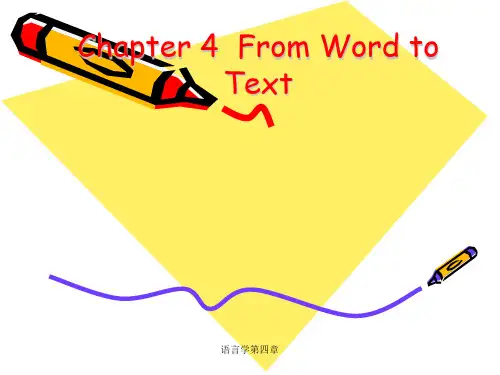
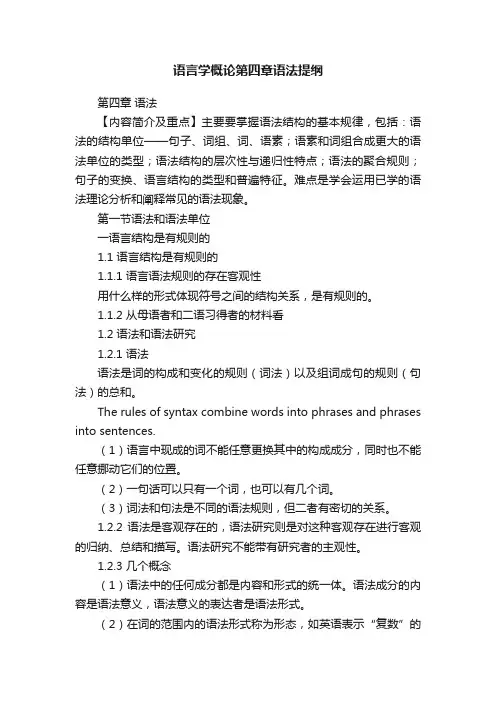
语言学概论第四章语法提纲第四章语法【内容简介及重点】主要要掌握语法结构的基本规律,包括:语法的结构单位——句子、词组、词、语素;语素和词组合成更大的语法单位的类型;语法结构的层次性与递归性特点;语法的聚合规则;句子的变换、语言结构的类型和普遍特征。
难点是学会运用已学的语法理论分析和阐释常见的语法现象。
第一节语法和语法单位一语言结构是有规则的1.1 语言结构是有规则的1.1.1 语言语法规则的存在客观性用什么样的形式体现符号之间的结构关系,是有规则的。
1.1.2 从母语者和二语习得者的材料看1.2 语法和语法研究1.2.1 语法语法是词的构成和变化的规则(词法)以及组词成句的规则(句法)的总和。
The rules of syntax combine words into phrases and phrases into sentences.(1)语言中现成的词不能任意更换其中的构成成分,同时也不能任意挪动它们的位置。
(2)一句话可以只有一个词,也可以有几个词。
(3)词法和句法是不同的语法规则,但二者有密切的关系。
1.2.2 语法是客观存在的,语法研究则是对这种客观存在进行客观的归纳、总结和描写。
语法研究不能带有研究者的主观性。
1.2.3 几个概念(1)语法中的任何成分都是内容和形式的统一体。
语法成分的内容是语法意义,语法意义的表达者是语法形式。
(2)在词的范围内的语法形式称为形态,如英语表示“复数”的“-s”就是一种形态。
词序表示词与词的关系,超出了词的范围,因此词序不是形态。
(3)把具有共同特点的语法形式概括起来就成为一种语法手段。
如附加语素和词序就是两种语法手段。
(4)语法最重要的特点是它的抽象性。
二语法的组合规则和聚合规则2.1 语法的两个基本规则2.1.1 组合规则语法单位互相连接起来构成更大的语言片断的规则叫做语法的组合规则。
2.1.2 聚合规则指语法单位的归类的规则。
语法上能够出现在相同句法位置上的词形成一个聚合,如果用来替换的不是从这个聚合里选出的词,句子也不能成立。
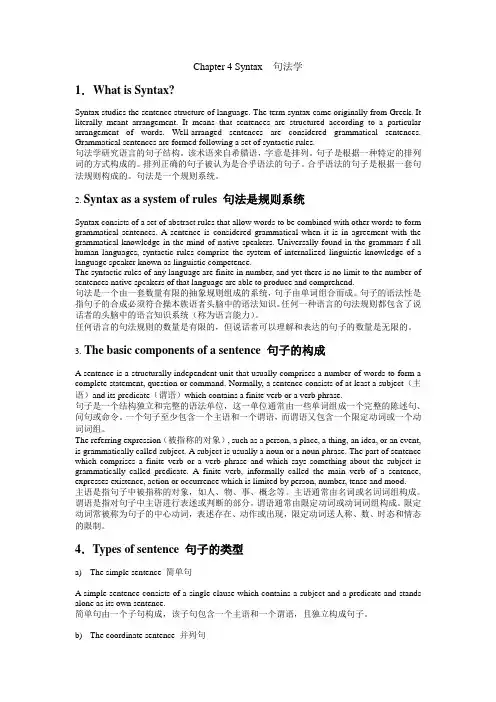
Chapter 4 Syntax 句法学1.W hat is Syntax?Syntax studies the sentence structure of language. The term syntax came originally from Greek. It literally meant arrangement. It means that sentences are structured according to a particular arrangement of words. Well-arranged sentences are considered grammatical sentences. Grammatical sentences are formed following a set of syntactic rules.句法学研究语言的句子结构。
该术语来自希腊语,字意是排列。
句子是根据一种特定的排列词的方式构成的。
排列正确的句子被认为是合乎语法的句子。
合乎语法的句子是根据一套句法规则构成的。
句法是一个规则系统。
2. Syntax as a system of rules 句法是规则系统Syntax consists of a set of abstract rules that allow words to be combined with other words to form grammatical sentences. A sentence is considered grammatical when it is in agreement with the grammatical knowledge in the mind of native speakers. Universally found in the grammars f all human languages, syntactic rules comprise the system of internalized linguistic knowledge of a language speaker known as linguistic competence.The syntactic rules of any language are finite in number, and yet there is no limit to the number of sentences native speakers of that language are able to produce and comprehend.句法是一个由一套数量有限的抽象规则组成的系统,句子由单词组合而成。
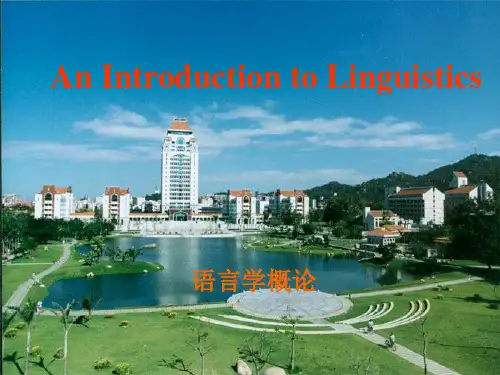

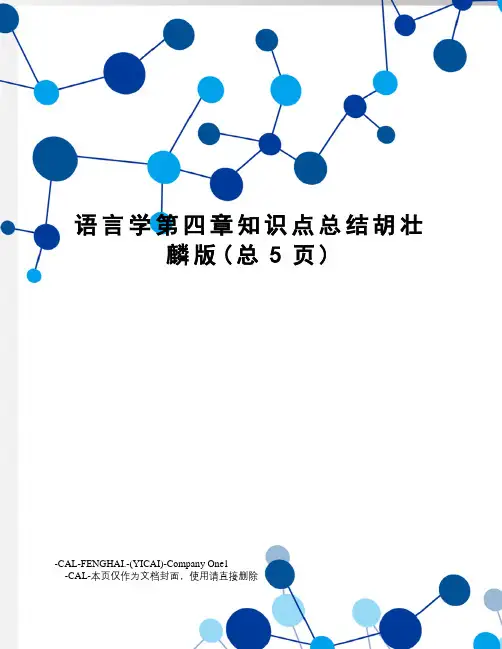
语言学第四章知识点总结胡壮麟版(总5页)-CAL-FENGHAI.-(YICAI)-Company One1-CAL-本页仅作为文档封面,使用请直接删除Chapter 4syntactic (句法的) relationspositional relation(位置关系)For language to fulfill its communicative function, it must have a way to mark the grammatical roles of the various phrase that can occur in a clause.Positional relation or word order refers to the sequential (有序的) arrangement of words in a language.Positional relation are a manifestation(表现)of one aspect of syntagmatic relations Word order is among the three basic ways (word order genetic and classification) to classify language words.Six possible types of language SVO VSO SOV OVS VOS English is SVO.relation of substitutability(可代替性)Firstly relation of substitutability refers to classes or sets of words substitutable of each other grammatically in sentence with the same structure.Secondly it refers to groups of more than one word which may be jointlysubstitutable grammatically for a single word of a particular set.This is what Saussure called associative(联想的) relations or in Hjemslev ’s paradigmatic(纵聚性的) relation.relation of co-occurrence(共现)Means words of different sets of clauses may permit pr require the occurrence of a word of another set or class to from a sentence or a particular part of a sentence. Thus relations of co-occurrence partly belong to syntagmatic rations partly to paradigmatic relations.grammatical construction and its constituentsGrammatical constructionAny syntactic string of words ranging from sentences over phrases structures to certain complex lexemes(词位)immediate constituents(直接成分)Constituent is a part of a larger linguistic unit. Several constituents together form a construction:SNP VPDe t N V NPDe t NThe girl ate the appleThis is tree diagram. 在句子结构分析中,成分用来指任何语言单位,而该单位又是更大语言单位的一部分,如在The girl ate the apple 本身的(A) the boy(B) ate the apple (C)都是一个成分,成分可以和其他成分组合组成更大的单位,如果两个成分B(the boy )C (ate the apple)结合起来形成一个更高的成分A Word-levelN=nounA=adjectiveV=verbP=prepositionDet=determinerAdv=adverbConj=conjunctionPhrasalNP=noun phraseAP=adjective phraseVP=verb phrasePP=preposition phraseS=sentence or clauseTo dismantle a grammatical constructure is this way is called immediate constituents or IC analysis.Bracketing is not as common in use, but it is an economic notation in representing the constituent/phrase structure of a grammatical unit.(((The) (girl)) ((ate) ((the) (apple))))Endocentric and Exocentric ConstructionsEndocentric construction is one whose distribution is functionally equivalent to that of one or more of its constituents, ., a word or a group of words, which serves as a definable centre or head.Usually noun phrases, verb phrases and adjective phrases belong to endocentric types because the constituent items are subordinate to the Head.and Exocentric ConstructionsEndocentric(相信结构)Endocentric construction is one whose distribution is functionally equivalent to that of one or more of its constituents, ., a word or a group of words, which serves as a definable centre or head.Usually noun phrases, verb phrases and adjective phrases belong to endocentric types because the constituent items are subordinate to the Head.Exocentric(并列结构)Exocentric construction refers to a group of syntactically related words where none of the words is functionally equivalent to the group as a whole, that is, there is no definable “Centre” or “Head” inside the group, usually includingthe basic sentence,the prepositional phrase,the predicate (verb + object) construction, andthe connective (be + complement) construction.Coordination and SubordinationEndocentric constructions fall into two main types, depending on the relation between constituents:Coordination (并列)is a common syntactic pattern in English and other languages formed by grouping together two or more categories of the same type with the help of a conjunction such as and, but and or .Coordination of NPs:[NP the lady] or [NP the tiger]Coordination of VPs:[VP go to the library] and [VP read a book ]Coordination of PPs:[PP down the stairs] and [PP out the door ]Coordination of APs:[AP quite expensive] and [AP very beautiful]Coordination of Ss:[S John loves Mary] and [S Mary loves John too].Subordination(从属) refers to the process or result of linking linguistic units so that they have different syntactic status, one being dependent upon the other, and usually a constituent of the other.The subordinate constituents are words which modify the head. Consequently, they can be called modifiers.Clauses can be used as subordinate constituents. There are three basic types of subordinate clauses:. Syntactic(句法) FunctionThe syntactic function shows the relationship between a linguistic form and other parts of the linguistic pattern in which it is used.Names of functions are expressed in terms of subjects, objects, predicators, modifiers, complements, etc.SubjectIn English, the subject of a sentence is often said to be the agent, or the doer of the action, while the object is the person or thing acted upon by the agent.In order to account for the case of subject in passive voice, we have two other terms “grammatical subject” and “logical subject”Word orderSubject ordinarily precedes the verb in the statement:Pro-formsThe first and third person pronouns in English appear in a special form when the pronoun is a subject, which is not used when the pronoun occurs in other positions: Agreement with the verbIn the simple present tense, an -s is added to the verb when a third person subject is singular, but the number and person of the object or any other element in the sentence have no effect at all on the form of the verbContent questionsIf the subject is replaced by a question word (who or what), the rest of the sentence remains unchanged, as in(范畴)The term category refers to the defining properties of these general units: Categories of the noun: number, gender, case and countabilityCategories of the verb: tense, aspect, voiceNumberNumber is a grammatical category used for the analysis of word classes displaying such contrasts as singular, dual, plural, etc.性)Such contrasts as “masculine : feminine : neuter”, “animate : inanimate”, etc. for the analysis of word classes.(格)The case category is used in the analysis of word classes to identify the syntactic relationship between words in a sentence.(or concord) may be defined as the requirement that the forms of two or more words of specific word classes that stand in specific syntactic relationship with one another shall also, be characterized by the same paradigmatically marked category (or categories).sentence types: QuirkSVC Mary is kind.a nurse.SVA Mary is here.in the house.SV The child is laughing.SVO Somebody caught the ball.SVOC We have proved him wrong.a fool.SVOA I put the plate on the table.SVOO She gives me expensive presents.(递归性)Recursiveness mainly means that a phrasal constituent can be embedded within another constituent having the same category, but it has become an umbrella term such important linguistic phenomena as coordination and subordination, conjoining and embedding, hypotactic and paratactic.Theoretically, there is no limit to the embedding of one relative clause into another relative clause, so long as it does not become an obstacle to successful communication.coordination.Conjunctions: and, but, and or.联系一个小句或者其他并列或链接的过程,通过这种过程组成的句子即并列(嵌入)Embedding: subordination.Main clauses and subordinate clauses.Three basic types of subordinate clauses:Relative clause:Complement clause:Adverbial clause:。
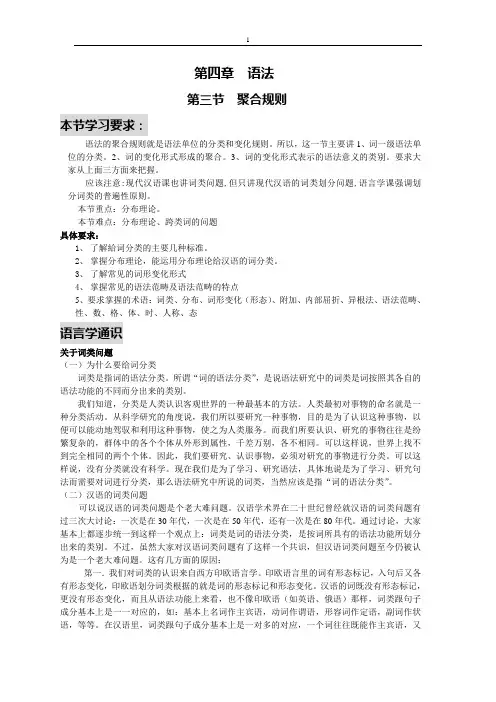
第四章语法第三节聚合规则本节学习要求:语法的聚合规则就是语法单位的分类和变化规则。
所以,这一节主要讲1、词一级语法单位的分类。
2、词的变化形式形成的聚合。
3、词的变化形式表示的语法意义的类别。
要求大家从上面三方面来把握。
应该注意:现代汉语课也讲词类问题,但只讲现代汉语的词类划分问题,语言学课强调划分词类的普遍性原则。
本节重点:分布理论。
本节难点:分布理论、跨类词的问题具体要求:1、了解給词分类的主要几种标准。
2、掌握分布理论,能运用分布理论给汉语的词分类。
3、了解常见的词形变化形式4、掌握常见的语法范畴及语法范畴的特点5、要求掌握的术语:词类、分布、词形变化(形态)、附加、内部屈折、异根法、语法范畴、性、数、格、体、时、人称、态语言学通识关于词类问题(一)为什么要给词分类词类是指词的语法分类。
所谓“词的语法分类”,是说语法研究中的词类是词按照其各自的语法功能的不同而分出来的类别。
我们知道,分类是人类认识客观世界的一种最基本的方法。
人类最初对事物的命名就是一种分类活动。
从科学研究的角度说,我们所以要研究一种事物,目的是为了认识这种事物,以便可以能动地驾驭和利用这种事物,使之为人类服务。
而我们所要认识、研究的事物往往是纷繁复杂的,群体中的各个个体从外形到属性,千差万别,各不相同。
可以这样说,世界上找不到完全相同的两个个体。
因此,我们要研究、认识事物,必须对研究的事物进行分类。
可以这样说,没有分类就没有科学。
现在我们是为了学习、研究语法,具体地说是为了学习、研究句法而需要对词进行分类,那么语法研究中所说的词类,当然应该是指“词的语法分类”。
(二)汉语的词类问题可以说汉语的词类问题是个老大难问题。
汉语学术界在二十世纪曾经就汉语的词类问题有过三次大讨论:一次是在30年代,一次是在50年代,还有一次是在80年代。
通过讨论,大家基本上都逐步统一到这样一个观点上:词类是词的语法分类,是按词所具有的语法功能所划分出来的类别。
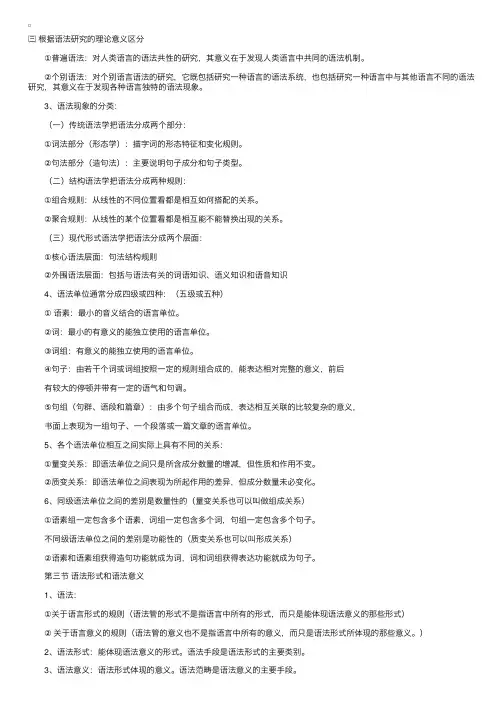
㈢根据语法研究的理论意义区分 ①普遍语法:对⼈类语⾔的语法共性的研究,其意义在于发现⼈类语⾔中共同的语法机制。
②个别语法:对个别语⾔语法的研究,它既包括研究⼀种语⾔的语法系统,也包括研究⼀种语⾔中与其他语⾔不同的语法研究,其意义在于发现各种语⾔独特的语法现象。
3、语法现象的分类: (⼀)传统语法学把语法分成两个部分: ①词法部分(形态学):描字词的形态特征和变化规则。
②句法部分(造句法):主要说明句⼦成分和句⼦类型。
(⼆)结构语法学把语法分成两种规则: ①组合规则:从线性的不同位置看都是相互如何搭配的关系。
②聚合规则:从线性的某个位置看都是相互能不能替换出现的关系。
(三)现代形式语法学把语法分成两个层⾯: ①核⼼语法层⾯:句法结构规则 ②外围语法层⾯:包括与语法有关的词语知识、语义知识和语⾳知识 4、语法单位通常分成四级或四种:(五级或五种) ①语素:最⼩的⾳义结合的语⾔单位。
②词:最⼩的有意义的能独⽴使⽤的语⾔单位。
③词组:有意义的能独⽴使⽤的语⾔单位。
④句⼦:由若⼲个词或词组按照⼀定的规则组合成的,能表达相对完整的意义,前后 有较⼤的停顿并带有⼀定的语⽓和句调。
⑤句组(句群、语段和篇章):由多个句⼦组合⽽成,表达相互关联的⽐较复杂的意义, 书⾯上表现为⼀组句⼦、⼀个段落或⼀篇⽂章的语⾔单位。
5、各个语法单位相互之间实际上具有不同的关系: ①量变关系:即语法单位之间只是所含成分数量的增减,但性质和作⽤不变。
②质变关系:即语法单位之间表现为所起作⽤的差异,但成分数量未必变化。
6、同级语法单位之间的差别是数量性的(量变关系也可以叫做组成关系) ①语素组⼀定包含多个语素,词组⼀定包含多个词,句组⼀定包含多个句⼦。
不同级语法单位之间的差别是功能性的(质变关系也可以叫形成关系) ②语素和语素组获得造句功能就成为词,词和词组获得表达功能就成为句⼦。
第三节语法形式和语法意义 1、语法: ①关于语⾔形式的规则(语法管的形式不是指语⾔中所有的形式,⽽只是能体现语法意义的那些形式) ②关于语⾔意义的规则(语法管的意义也不是指语⾔中所有的意义,⽽只是语法形式所体现的那些意义。
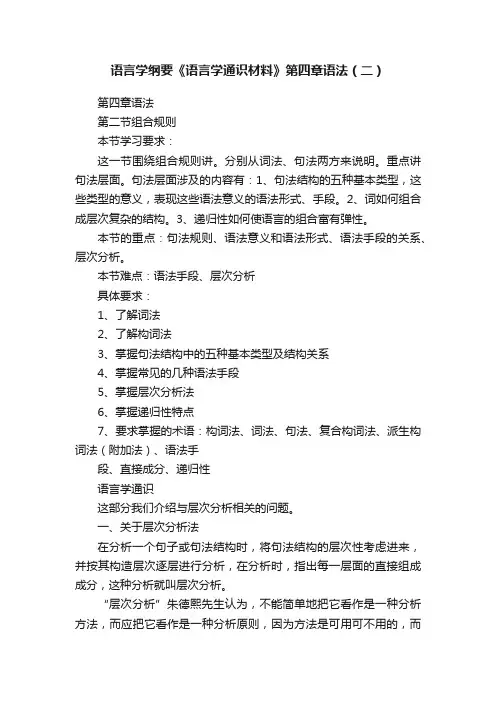
语言学纲要《语言学通识材料》第四章语法(二)第四章语法第二节组合规则本节学习要求:这一节围绕组合规则讲。
分别从词法、句法两方来说明。
重点讲句法层面。
句法层面涉及的内容有:1、句法结构的五种基本类型,这些类型的意义,表现这些语法意义的语法形式、手段。
2、词如何组合成层次复杂的结构。
3、递归性如何使语言的组合富有弹性。
本节的重点:句法规则、语法意义和语法形式、语法手段的关系、层次分析。
本节难点:语法手段、层次分析具体要求:1、了解词法2、了解构词法3、掌握句法结构中的五种基本类型及结构关系4、掌握常见的几种语法手段5、掌握层次分析法6、掌握递归性特点7、要求掌握的术语:构词法、词法、句法、复合构词法、派生构词法(附加法)、语法手段、直接成分、递归性语言学通识这部分我们介绍与层次分析相关的问题。
一、关于层次分析法在分析一个句子或句法结构时,将句法结构的层次性考虑进来,并按其构造层次逐层进行分析,在分析时,指出每一层面的直接组成成分,这种分析就叫层次分析。
“层次分析”朱德熙先生认为,不能简单地把它看作是一种分析方法,而应把它看作是一种分析原则,因为方法是可用可不用的,而原则是必须遵守的。
我们进行句法分析时,则必须按句法构造的层次性进行分析。
层次分析实际包含两部分内容,一是切分,一是定性。
切分,是解决一个结构的直接组成成分到底是哪些,换句话说,一个句子或句法结构到底该在什么地方切分。
如“他刚来”这个句子,从结构上说,首先该在“他”和“刚”之间切分呢,还是在“刚”和“来”之间切分,这考虑的就是切分问题。
定性,是解决切分所得的直接组成成分之间在句法上是什么关系。
再拿“他刚来”来说,在切分问题解决之后,“他”和“刚来”之间是什么句法关系,“刚”和“来”之间是什么句法关系,这考虑的就是定性问题。
层次分析的基本精神1.承认句子或句法结构在构造上有层次性,并在句法分析中严格按照其内部的构造层次进行层次分析。
2.每一次分析都要明确说出每一个构造层面的直接组成成分(Immediate Constituents)。

---------------------------------------------------------------最新资料推荐------------------------------------------------------ 语言学概论讲义第四章语法二第四章语法本章基本内容本章重点和难点第一节语法的性质第二节语法研究的内容、类别和单位第三节语法形式和语法意义第四节语法单位的聚合和组合2011年7月13日第三章-语音1/ 18本章基本内容语法的性质和特点、语法研究的内容、语法现象的分类和语法成分的单位;语法形式与语法意义及其关系,语法形式的主要手段和语法意义的主要范畴;语法单位的聚合规则与组合规则。
2011年7月13日语言学概论-第四章-基本内容---------------------------------------------------------------最新资料推荐------------------------------------------------------ 第一节语法的性质一、语法是组词造句的规则二、语法规则的性质和特点三、语法和其他一些现象的关系2011年7月13日语言学概论-第四章-第一节3/ 18一、语法是组词造句的规则语法本质上是说本族语的人头脑中潜在的一种直觉知识,是人们说话时的一种约定习惯,是组词造句的规则。
组词造句的规则例:1、我认识这个人。
2、人我这认识个。
3、我这认识个人。
4、这个我人认识。
√2011年7月13日语言学概论-第四章-第一节---------------------------------------------------------------最新资料推荐------------------------------------------------------二、语法规则的性质和特点1、语法的抽象性。
2、语法的递归性。
语言学第四章要点(2011-10-11 21:15:48)说明:本章要点参考了多本教材,其中的X-bar theory, Universal Grammar, merger and move等部分仅供考研的同学参考。
其他同学不做要求。
第四章Syntax句法学1.Syntax定义is a subfield of linguistics that studies the sentence structure of language. Sentences are structured according to particular arrangement of words.2、Syntax as a system of rules. as a major component of grammar, syntax consists of a set of abstract rules that allow words to be combined with other words to form grammatical sentences3、Sentence structureSubject all language have ways of referring to some entity, such as a person , a place, a thing, an idea, or an event, this referring expression is grammatically called subject. A subject may be a noun or a noun phrase in a sentence that usually precedes the predicate.2.Type of sentence英语的句子中的三种基本类型是什么?Traditionally, three major types of sentences are distinguished. They are simple sentence, coordinate or compound sentence and complex sentence.A simple sentence consists of a single clause which contains a subject and a predicate and stands alone as its own sentence. For example, ① John reads extensively. the sentences contains a single clause and can stand structurally independent.A coordinate sentence并列句 contains two clauses joined by a linking word called coordinat ing conjunction, such as “and”, “but”, “or”. The two clauses in a coordinate sentence are structurally equal parts of the sentence; neither is subordinate to the other. For example, ③ John is reading a linguistic book, and Mary is preparing for her history exam.A complex sentence contains two or more clauses, one of which is incorporated into the other. The two clauses in a complex sentence have unequal status, one subordinating the other. The incorporated, or subordinate, clause is normally called an embedded clause子句, and the clause into which it is embedded is called a matrix sentence主句. For example, ⑤ Mary told Jane [that John liked linguistics]. In the above examples, the clauses in the square brackets are embedded clauses. Theyare subordinate to the clauses outside the brackets which are called matrix clauses.A complex sentence的特征:Some conclusions can be drawn from the complex sentence.1、an embedded clause functions as a grammatical unit in its matrix clause.2.most embedded clauses require an introductory word called a subordinator, such as “that”,” if ”.3.an embedded clause may not function as a grammatically well-formed sentence if it stands independently as a simple sentence unless it form changes.3、linearly- and hierarchically-structured.(线形结构和层次结构Language is a highly structured system of communication. Sentences are not formed by randomly(随意)combining lexical items, but by following a set of syntactic rules that arrange linguistic elements in a particular order to make a string of words not only meaningful but also linearly- and hierarchically-structured.(线形结构和层次结构)Hierarchical structure: the sentence structure that groups words into structural constituents and shows the syntactic categories of each structural constituent, such as NP and VP.5、Syntactic categories:句法类型1.lexical categories词类 (four major lexical categories and six minor lexical categories)2. Phrasal categories 短语类(lexical items have certain combinational properties that allow them to combine with words of different categories to form phrase. NP VP PP AP)6、Grammatical relations(语法关系) The structural and logical relations of constituents are called grammatical relations. It concerns the way each noun phrase in the sentence relates to the verb. (who does what do whom). Structural vs. logical subject, object. (**)7、Combinational rules组合规则1、Phrase structural rules The combinational pattern in a linear formula may be called a phrase structural rule, or rewrite rule. It allows us to better understand how words and phrases form sentences, and so on.2、Syntactic movement and movement rules Syntactic movement occurs whena constituent in a sentence moves out of its original place to a new position, the sentence involving which cannot be described by phrase structure rules. It was governed by transformational rules, the operationof which may change the syntactic representation of a sentence (句法的表达方式).3、什么是X-标杆理论?X-bar theory is a general and highly abstract schema that collapses all phrasal structure rules into a single format: X″→ (Spec) X (Compl). In this format, Spec stands for specifier while Compl stands for complement. This theory is capable of reducing the redundancies of individual phrasal structure rules and may well capture certain basic properties shared by all phrasal categories, i.e. NP, VP, AP, PP, across the languages of the world.4、Syntactic movement and movement rulesSyntactic movement occurs when a constituent in a sentence moves out of its original place to a new position, the sentence involving which cannot be described by phrase structure rules. It was governed by transformational rules, the operation of which may change the syntactic representation of a sentence (句法的表达方式).1 NP-movement and WH-movementNP-movement occurs when, for example, a sentence changes from the active voice to the passive voice (postpose, prepose).WH-movement is obligatory in English. It changes a sentence from affirmative to interrogative.2 Other types of movementAUX-movement (auxiliary)3 D-structure and S-structureThe syntactic component of the grammar:Phrase Structure Rules + the Lexicon (词汇)(generate)―――D-structure (deep structure) ―――Movement Rules ( transform)―――― S-structure (Surface structure) A sentence may not look different when it is at different syntactic levels. Since syntactic movement does not occur to all sentences, the D-structure and S-structure of some sentences look exactly the same at different levels of representation.4 Moreα-a general movement ruleThere is a general movement rule accounting for the syntactic behavior of any constituent movement, called Moveα(or Move Alpha), which means “move any constituent to any place”. The problem is Moveαis too powerful and the grammar should include some conditions which will restrain this power and stimulate tha t only “certain constituents” move to “certain positions”.7、Toward a theory of universal grammarSince early 1980s, Noam Chomsky and other generative linguists proposed and developed a theory of universal grammar (UG) known as the principles and parameters theory. According to Chomsky, UG is a system of linguistic knowledge and a human species-specific gift, which exists in the mind or brain of a normal human being. According to principles-and-parameters framework, UG consists of a set of general conditions, or general principles, that generate phrases and at the same time restrain the power of Moveα, thus preventing this rule from applying in certain cases. UG also contains a set of parameters that allow general principles to operate in certain ways, according to which particular grammar of natural languages vary。
语言学概论第四章教学辅导第一部分重点难点解析第四章:语法语法部分要特别注意分析问题,要学得活,要注意融汇贯通,不要死记硬背。
语法内容比较多,名词概念也多,学习要特别注意。
进一步认识把握组合规则和聚合规则的内涵;学会灵活分析种种语法现象;注意掌握众多的名词概念。
第一节语法和语法单位一、什么是语法语法就是词的构造、变化的规则和用词造句的规则,是语言在其长期发展过程中形成的,这种规则是客观存在于一种语言之中,是语言长期发展过程中形成的,说这种语言的全体成员必须共同遵守。
例如汉族人说“我看书”,“书”一般放在“看”的后面,而日本人说这句话则是“我书看”,即把宾语“书”放在动词“看”的前面,这里语序上的差别,就是语法上的差别,反映了汉语和日语的不同特点。
二、语法规则语法规则主要是指组合规则和聚合规则。
语法的组合规则和聚合规则构成一种语言的语法规则。
语法的组合规则是指语法单位一个接一个组合起来的规则,这种规则是现实的,存在于话语之中,虽然看不见摸不着,但它客观存在,说这种语言的人必须共同遵守,否则就会造成错误的句子,说出谁也听不懂的话来。
例如“太阳、红色的、起来、升”,可以组成“红色的太阳升起来”,不能进行别的组合,否则就违反了组合规则。
语法的聚合规则是指语法单位的归类和变化的规则。
几个语法单位(主要指词),互相在同一位置可以替换,替换后结构类型和功能都没有变化,这样的几个语法单位,就形成了一种聚合关系。
用聚合群中的单位替换同一组合中的某个单位,可以生成许多具体的句子。
聚合为句子的生成提供了无数的可能性,因为聚合规则是潜存在人脑中的,掌握了一定的组合规则后,人们可以利用聚合规则,用同一类别的词语进行替换,造成符合自己需要的句子。
例如学会了“我看书”,其中的“书”在具体的语境中就可以替换为潜存于人脑中的“报纸”、“小说”、“电影”、“电视”、“风景”等等,造出无限对的句子来,满足交际的需要。
三、语法单位凡是能在组合的某一位置上被替换下来的片段都是语法单位。
第四章语法第二节组合规则本节学习要求:这一节围绕组合规则讲。
分别从词法、句法两方来说明。
重点讲句法层面。
句法层面涉及的内容有:1、句法结构的五种基本类型,这些类型的意义,表现这些语法意义的语法形式、手段。
2、词如何组合成层次复杂的结构。
3、递归性如何使语言的组合富有弹性。
本节的重点:句法规则、语法意义和语法形式、语法手段的关系、层次分析。
本节难点:语法手段、层次分析具体要求:1、了解词法2、了解构词法3、掌握句法结构中的五种基本类型及结构关系4、掌握常见的几种语法手段5、掌握层次分析法6、掌握递归性特点7、要求掌握的术语:构词法、词法、句法、复合构词法、派生构词法(附加法)、语法手段、直接成分、递归性语言学通识这部分我们介绍与层次分析相关的问题。
一、关于层次分析法在分析一个句子或句法结构时,将句法结构的层次性考虑进来,并按其构造层次逐层进行分析,在分析时,指出每一层面的直接组成成分,这种分析就叫层次分析。
“层次分析”朱德熙先生认为,不能简单地把它看作是一种分析方法,而应把它看作是一种分析原则,因为方法是可用可不用的,而原则是必须遵守的。
我们进行句法分析时,则必须按句法构造的层次性进行分析。
层次分析实际包含两部分内容,一是切分,一是定性。
切分,是解决一个结构的直接组成成分到底是哪些,换句话说,一个句子或句法结构到底该在什么地方切分。
如“他刚来”这个句子,从结构上说,首先该在“他”和“刚”之间切分呢,还是在“刚”和“来”之间切分,这考虑的就是切分问题。
定性,是解决切分所得的直接组成成分之间在句法上是什么关系。
再拿“他刚来”来说,在切分问题解决之后,“他”和“刚来”之间是什么句法关系,“刚”和“来”之间是什么句法关系,这考虑的就是定性问题。
层次分析的基本精神1.承认句子或句法结构在构造上有层次性,并在句法分析中严格按照其内部的构造层次进行层次分析。
2.每一次分析都要明确说出每一个构造层面的直接组成成分(Immediate Constituents)。
再拿上面举的例子来说,“他刚来”这个句子,内中的三个词不再一个层面上,这个句子含有两个构造层面。
第一个层面,其直接组成成分是哪两个,第二个层面,其直接组成成分是哪两个,都必须明确说出。
3.在分析中,只管直接成分之间的语法结构关系,不管间接成分的语法结构关系,也不管句法结构中实词与实词之间的语义结构关系。
举例来说,“张三喝啤酒”,第一个层面的直接组成成分是“张三”和“喝啤酒”,它们之间是主谓关系;第二个层面的直接组成成分是“喝”和“啤酒”,它们之间是述宾关系。
这在分析中必须明确指出。
至于“张三”和“啤酒”之间是否有什么语法关系,“张三”和“喝”之间、“张三”和“啤酒”之间、“喝”和“啤酒”之间在语义上是什么关系,层次分析一概不管。
(参考书目:《现代汉语语法研究教程》陆俭明北京大学出版社2003年8月)二.关于替换和扩展“句法结构的层次”是一个非常重要的概念。
要深刻的理解这个问题,就还得先说明一下“替换”和“扩展”的概念。
(一).替换(substitution)“替换”是语言学里最基本的一种分析方法。
所谓“替换”(substitution)就是在一个语言组合里一个语言项目替代另一个语言项目的过程。
举例来说,假如有“AB”这样一个语言组合,把“B”抽掉,填上“C”,而“AC”成立;或者把“A”抽掉,填上“D”,而“DB”成立,这一抽一填的过程就是替换。
“替换”这种分析方法在语音研究中已被证明是用来确定音位最简便、有效的方法。
请看英语、汉语的两组例子:(1)a.[pin] pin 大头针b.[tin] tin 锡(2)a.[tian55] 颠b.[t‘ian55] 天通过替换可以发现,在英语里,[p]和[t]是对立的,也就是说有区别意义的作用,可见英语的[p]和[t]可以分别看作不同的音位。
通过替换可以知道,[t]和[t‘]在汉语里有区别意义的作用,也应分析为两个不同的音位。
在语法研究中,“替换”同样是不可缺少的分析手段。
比如说汉语里一个双音节的音段只是一个语素(morpheme)还是包含两个语素,也得通过替换来确定。
看几个例子:(3)白菜啤酒垃圾(3)中这三个双音节音段都有意义。
先看“白菜”。
“白菜”里的“白”和“菜”都可分别用另外的音节来替换,替换后的整个双音节音段依然有意义,而其中的“白”的意思都保持不变,内部结构关系也保持不变。
可见“白菜”包含两个语素,“白”和“菜”都是语素。
比较:(4) a.白菜白糖白药……(注:划线部分表示被替换的成分)b.白菜素菜香菜……“啤酒”里的“啤”可以用别的有意义的音节来替换,替换后整个双音节音段有意义,其中“酒”的意义保持不变;而“酒”则不能用别的有意义音节来替换。
虽然“啤酒”的替换情况跟“白菜”不同,但毕竟还是有可替换性,而且通过替换可以表明“酒”是语素,所以还可以认为“啤酒”包括两个语素,只是“啤”是通过证明跟它组合的“酒”是语素,然后才被确定为语素的,所以像“啤”这样的语素一般称之为“剩余语素”。
比较:(5)a.啤酒白酒黄酒……b.啤酒啤____“垃圾”则又是另一种情况:其中任何一个音节都不能由别的有意义的音节来替换。
可见其中的“垃”和“圾”都不能看成语素,整个双音节音段“垃圾”是一个语素。
比较:(6)a.垃圾垃____b.垃圾____圾语法研究中对词类的划分实际也用的是“替换”的方法。
例如:确定形容词可以用以下两条具体的标准:(1)能够出现在下列框架里:“很()”;(2)不能出现在下列框架里:“很()宾语”。
(注:(2)是与表示心理活动的动词区别)表面上看这里用的是结构框架,实际也是一种“替换”。
在上面所设定的框架里彼此有替换关系的词就是同一类的词――形容词。
因此,替换是语言研究中必须使用的基本方法。
“替换”又有两种情形:一种是“等量替换”,即替换不改变结构的长度。
例如:(7)看书→看报→看戏另一种是“不等量替换”,即替换一定改变结构的长度。
例如:(8)a.看电影→“电影”由“中国电影”替换看中国电影b.喜欢看电影→看“电影”由“看”替换喜欢看上面(8a)和(8b)还不完全一样。
(8a)是“超量替换”,即用以替换的语言项目的长度超过被替换的语言项目的长度(即“中国电影”>“电影”)。
(8b)是“差量替换”,即用以替换的语言项目的长度小于被替换的语言项目的长度(即“看”<“看电影”)。
“超量替换”的结果,造成句法结构的扩展;“差量替换”的结果,造成句法结构的紧缩。
上面说的“等量替换”一般归入“超量替换”。
(二).扩展(expend)句法结构中所谓“扩展”,一般的理解是指一个句法结构由简单变为复杂。
原先的词类序列称为“模型(model)”,扩展后的词类序列称为“扩展式(expended form)”。
(注:这里说“词类序列”是强调结构中不同的语法单位是否可以组合实际上是不同的词类的组合。
比如,甲类词和乙类词可以组合,甲类词中的成员才有可能和乙类词中的成员组合。
)“扩展”得满足三个条件:(1)扩展式在长度上超过模型;(2)扩展式与模型能有替换关系,即能在相同的语言环境中出现;(3)模型中被替换的语言项目到扩展式里以后,在那个用来替代的语言项目中居核心(head)地位。
例如:(9)a.买房子→买木头房子b.我不喝→我不喝啤酒c.来得早→来得早极了比如上面例(9a)“买木头房子”在长度上超过“买房子”,这就符合条件(1)。
又如:(10)a.买木头房子买房子b.买木头房子合算买房子合算c.买木头房子的人买房子的人d.张三买木头房子张三买房子e.买木头房子住买房子住比如上面(10a)“买木头房子”与“买房子”能在相同的语言环境中出现,这就符合条件(2)。
“买房子”里被替换的“房子”到了“买木头房子”里去后,在那个用来替代的“木头房子”里居核心地位,这就符合条件(3)。
可见例(9a)就是一个合法的扩展。
例(9b/c)的情况跟例(9a)相同。
可是下面例(11)就不是一个合法的“扩展式”。
比较:(11)*他爱干净→他爱干净的孩子上面(11)中“他爱干净的孩子”在长度上超过了“他爱干净”,这看起来也符合上述条件(1);同时“他爱干净的孩子”与“他爱干净”又能在相同的语言环境中出现,这看起来也符合上述条件(2)。
例如:(12)a1.听说他爱干净的孩子。
a2.听说他爱干净。
b1.他爱干净的孩子是事实。
b2.他爱干净是事实。
c1.兴许他爱干净的孩子。
c2.兴许他爱干净。
但是却不符合上述条件(3)。
因为“他爱干净”里被替代的“干净”,到“他爱干净的孩子”里去后,在那个用来替代的片段“干净的孩子”中不是居核心地位(即不是中心语)。
所以例(11)就不是一个合法的“扩展式”了。
从上面所谈的情况不难发现:“扩展”是通过“替换”实现的;但替换不一定造成“扩展”。
句法结构的“扩展”可以有三种类型:一种是“更迭性扩展(expansion by the supersession)”。
这种扩展是模型里的某个语言项目被一个包含该语言项目但长度超过该语言项目的新的语言项目所代替,从而构成一个长度超过原模型的新的扩展式。
例如:(13)a.老师的衣服→我的老师的衣服b.老师很能干→数学老师很能干c.做作业→做完作业d.买房子→买木头房子e.他去→他去广州f.马上说→马上说清楚另一种是“组合性扩展(expansion through the combination)”。
这种扩展是以模型作为一个整体跟另一个词的序列进行组合,从而构成一个长度超过原模型的新的扩展。
(14)a.去→我去b.书→新书c.清除了→不合格的会员清除了d.批判→批判康德学说e.吃饱→吃饱肚子f.唱红了→唱红了北京城更迭性扩展是结构复杂化必不可少的手段;组合性扩展是由词组合成句法结构所必不可少的手段,也是结构复杂化的一种手段。
这两种不同类型的扩展,从本质上说都可以看作是替换的结果。
不同的是:在更迭性扩展中,模型与扩展式都是实序列;而在组合性扩展中,模型里被替代的是个零形式序列,扩展式里那个用来替代的语言项目是个实序列。
也就是说:(15)a.更迭性扩展:XZ替换Z → XYZ(买房子→买木头房子)b.组合性扩展:XøY替换øXY(批判→批判康德学说)(注:ø代表零形式,表明该位置是空位,实际结果是用词序列占有空位,从而实现扩展,如(15b)用“康德学说”占据“批判”后面的空位,使模型长度加长,实现扩展的。
)除了上面两种扩展以外,还有一种扩展形式是“插入性扩展(expansion through the insertion)”。
这种扩展是在原模型中间插入一个词的序列,从而造成一个长度超过原型的新的句法结构。